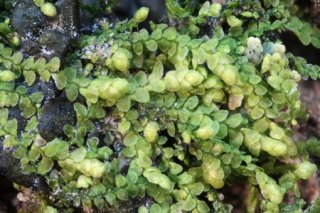The Lizard is justly recognised as a hotspot for mosses and liverworts, as much as it is for rare clovers, rushes and wild asparagus. This article explains more and highlights an exciting recent discovery.
Although much is known about the rare wildlife of The Lizard, there is plenty more to be revealed and, as a recent discovery has proven, some of it may have been right under our noses all along!

Mosses and liverworts, which are collectively termed bryophytes, tend to be less well studied than our more familiar higher plants; few people having the specialist knowledge to be able to separate the rare from the commonplace.
An expert, Dr Des Callaghan, was employed by Natural England in 2013/14 to undertake a stocktake of The Lizard’s rarest bryophytes, and despite his survey coinciding with the worst of the winter storms, he made some fascinating findings.
At the National Trust farm at Predannack for example, we have long known the significance of an inland serpentine outcrop within one of the grazed fields for Land Quillwort, Twin-headed Clover, Fringed Rupturewort and a host of other rare plants. However, Des discovered that this same spot also supports a hitherto unknown population of the rare Lizard Crystalwort, Riccia bifurca. He estimated that this newly discovered population is the largest known of this species, and is confined to The Lizard in Britain. It is designated a species “of principal importance for the purpose of conserving biodiversity” covered under section 41 (England) of the Natural Environment and Rural Communities [NERC] Act (2006).
Luckily the management we have had in place for a number of decades for the rare plants on the outcrop suits it just fine, with the cattle grazing and occasional scrub clearance keeping the turf open so the liverwort can thrive.
Another rare liverwort species that is associated with The Lizard is Atlantic Lejeunea (Lejeunea mandonii). This leafy liverwort likes damp alkaline rock faces and tree bark, and occurs along the valley at Poltesco. One of the sites it inhabits is the supporting stonework of a vehicular bridge. This meant we had to tread very carefully when the bridge needed replacing a few years ago, working with the experts to ensure that construction methods protected the plant. We had to remove some vegetation to allow scaffolding of the structure, but were careful to ensure that the trees crucial to maintaining the correct humidity for the plant remained in place, and that the somewhat bewildered builders knew that the ‘rare green slime’ was to be treated with care! It can be a difficult balancing act to maintain the correct humidity but not shade out the liverwort.
We are always thankful to the experts for their advice on this and other lower plant sites, and are only too happy to do what we can to aid their conservation on The Lizard. Such plants might be small and hard to identify, but they are a significant part of what makes our Peninsula distinct.
Published: March 2014
Author: Rachel Holder (National Trust Area Ranger)
